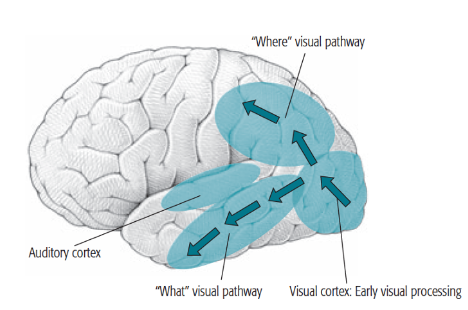C4 Mental imagery
1/25
Earn XP
Description and Tags
lec slideis on neglectistä asiaa
Name | Mastery | Learn | Test | Matching | Spaced |
|---|
No study sessions yet.
26 Terms
sensory modalities(?)
visual, olfactory, gustatory, tactile, auditory
overlap in visual perception and imagery processing
the two processes use partly the same MITÄÄ
there is debate about the extent to which perception/attention and mental imagery use the same processes
Roland and Friberg (1985): an early PET study (jingle, route), found that some of the same brain areas are active (in imagery and perception)
mental imagery
processing of perceptual-like information in the absence of an external source for the perceptual info
mental rehearsal in sports
epiphenomenon
JOKU that has no functional use
Santa (1977) visual vs. verbal mental imagery
lisää tähän kuva
verbal vs visual imagery
different parts of the brain are involved and information is represented and processed differently (Santa, Roland & Friberg)
mental rotation
response times are tied to the degree of angular disparity (Shepard & Metzler 1971) for both 2D and 3D
a mental process that appears analogous (vastaava) to physical action
NOT an epiphenomenon: has functional properties
related to spatial abilities in general: building LEGO
activates the parietal where-pathway
Brooks (1968): conflict between mental array and visual array scanning
diagram condition: Y/N answer for corners of a diagram (letter)
Sentence condition: Y/N answer for nouns
Y/N: pointing, tapping, saying
important finding: mental imagery and pointing to an array seem to use the same cognitive resources
Baddeley & Lieberman (1976): image scanning dual task
F-task (from the Brooks experiment) while either judging brightness levels (visual) or keeping a light beam on a pendulum while blindfolded (spatial)
spatial scanning action interfered most with the mental scanning
Moyer (1973): judging the relative size of two animals (Judgements on imagined vs physical images/objects)
done as a mental exercise: no pictures, only from memory
the smaller the difference in size, the longer the judgement time
Finke et al (1989): Judgements on imagined vs physical images/objects
Ppl can make judgments on imagined objects and come to the same conclusions as they would with seen objects
e.g. Imagine a capital letter N, connect a diagonal line from the top right corner to the bottom left corner. Now rotate the figure 90 degrees. What do you see?

Chambers and Reisberg (1985): rabbit/duck photo (Judgements on imagined vs physical images/objects)
a reversible figure was shown to participants for a short time for them to form a mental image
participants were able to interpret a reversible figure in only one way, and mental imagery did not allow them to find the other interpretation → contrast to visual perception
initial evidence that there are differences between a mental image and actual visual perception of an object
mental imagery seems mostly unambiguous (yksikäsitteinen)
another study (peterson et al 1992) found that more explicit instructions helped but was still hard
O’Craven and Kanwisher (2000): Brain areas activated by imagery vs perception (Judgements on imagined vs physical images/objects)
Task: look at or imagine faces or places
Findings:
the parahippocampal place area activated in both imagery and perception of places (although somewhat weaker with imagery)
the fusiform face area activated in both imagery and perception of faces (although somewhat weaker with imagery)
= brain areas activated by imagery correspond to those activated by perception
less clarity about the primary visual cortex’s activation
Kosslyn et al (1999): transcranial magnetic stimulation (Judgements on imagined vs physical images/objects)
participants made imagery judgements slower after receiving TMS to the primary visual cortex
Judgements on imagined vs physical images/objects: STUDIES
Moyer (1973): animal sizes
Finke et al (1989) : N to hourglass
Chambers and Reisberg (1985): duck/rabbit
O’Craven and Kanwisher (2000): faces houses brain activation
Kosslyn et al (1999): TMS to primary visual cortex + imagery judgments
Levine, Warach & Farah (1985): The what and where pathways in mental imagery
a patient with bilateral (molemminpuolinen) parietal damage (where-path) could not describe locations of familiar objects but could describe appearance
a patient with a temporal lesion couldn’t describe appearance but could describe location

Cognitive maps
mental representations of the location of objects and places in the environment
route map
survey map
study: Thorndyke and Hayes-Roth (1982)
study: Hartley et al (2003)
study: london taxi drivers have higher grey matter density in posterior hippocampal structures due to strong survey maps
route map
cognitive map consisting of the paths between locations; emphasizes action info
egocentric representation
survey map
cognitive map consisting of the position of locations in space; emphasizes spatial info
allocentric representation
Thorndyke and Hayes-Roth (1982): cognitive map study
ability of secretaries to find their way around a building
findings: secretaries often used route plans, and it typically took years to form a survey map
Hartley et al (2003): neural basis of cognitive maps
participants navigated a virtual reality town in 2 conditions
way-finding (survey map)
route-following (route map)
TÄHÄN LISSEE
Representations of space
egocentric
allocentric
egocentric representation of space
“space as we see it”; relative to own body; relates to route maps
parietal
allocentric representation of space
not specific to a particular viewpoint; relates to survey maps
hippocampal
physical maps and mental rotation
when it isn’t possible to rotate a physical map, ppl show an effect similar to mental rotation: degree of mis-orientation affects time needed to find an object on a map (Gunzelman & Anderson 2002)
map distortion
Stevens and Coupe 1978: when ppl have to judge the relative position of two locations, they often use the larger areas to which these locations belong to for the judgements
e.g. gothenburg is west of copenhagen even though denmark is west of sweden